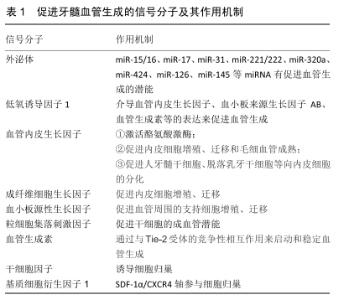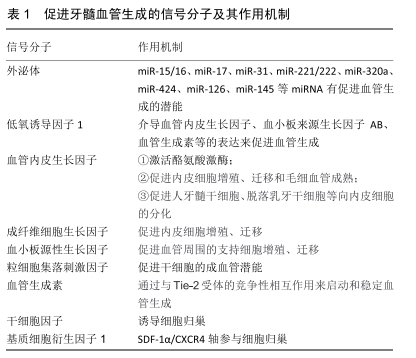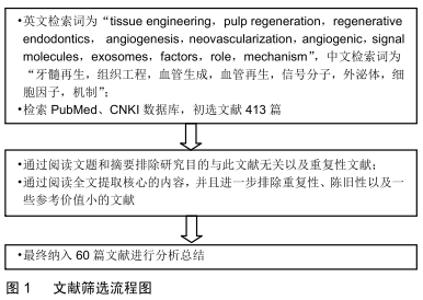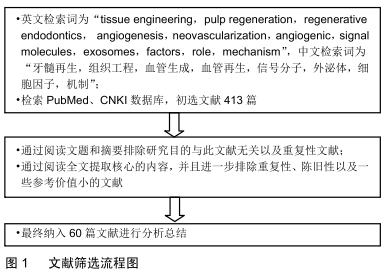Chinese Journal of Tissue Engineering Research ›› 2020, Vol. 24 ›› Issue (14): 2263-2270.doi: 10.3969/j.issn.2095-4344.2461
Previous Articles Next Articles
Role of angiogenesis in dental pulp regeneration: exosomes and angiogenic factors#br#
Chen Ting1, 2, Li Xinzhu1, 2, Xu Wenan1, 2
- 1Nanfang Hospital, Southern Medical University/The First School of Clinical Medicine, Southern Medical University, Guangzhou 510515, Guangdong Province, China; 2School of Stomatology, Southern Medical University, Guangzhou 510515, Guangdong Province, China
-
Received:2019-06-29Revised:2019-07-02Accepted:2019-08-09Online:2020-05-18Published:2020-03-16 -
Contact:Xu Wenan, MD, Associate professor, Nanfang Hospital, Southern Medical University/The First School of Clinical Medicine, Southern Medical University, Guangzhou 510515, Guangdong Province, China; School of Stomatology, Southern Medical University, Guangzhou 510515, Guangdong Province, China -
About author:Chen Ting, Nanfang Hospital, Southern Medical University/The First School of Clinical Medicine, Southern Medical University, Guangzhou 510515, Guangdong Province, China; School of Stomatology, Southern Medical University, Guangzhou 510515, Guangdong Province, China -
Supported by:the National Natural Science Foundation of China, No. 81700956; 2018 Provincial College Students Innovation Training Program of Southern Medical University, No. 201812121134; Dean’s Fund of Southern Hospital Affiliated to Southern Medical University, No. 2016B028
CLC Number:
Cite this article
Chen Ting, Li Xinzhu, Xu Wenan. Role of angiogenesis in dental pulp regeneration: exosomes and angiogenic factors#br#[J]. Chinese Journal of Tissue Engineering Research, 2020, 24(14): 2263-2270.
share this article

2.2 外泌体(Exosomes) 近年来外泌体的研究比较热门,因其细胞间通讯功能,外泌体在疾病标志物、生理病理功能、天然药物载体等方面都担当着很重要的角色[3]。外泌体是一种直径30-150 nm不等、具有内吞作用的细胞外囊泡,囊泡中包含有蛋白质、脂质和遗传物质如DNA、mRNA、microRNA等。外泌体存在于几乎所有的细胞、体液、细胞间隙中,大多数细胞包括正常和病理细胞在培养过程中都分泌这种囊泡[4]。囊泡膜的表面有特异识别功能的蛋白质如四聚体蛋白、膜联蛋白和主要组织相容性复合物等[5],这样它们可被邻近或远处的细胞选择性地吸收,利用它们的生物活性化合物对受体细胞进行重新编程。 干细胞分泌的外泌体对再生医学具有重要意义,在牙髓再生领域也有文献报道外泌体在血管生成中起到重要作用。目前认为,外泌体主要通过保持内皮细胞的活性和增殖能力来促进血管生成[6]。 柳鑫等[7]发现人牙髓干细胞的外泌体可提高内皮细胞的增殖、迁移、侵袭能力,且其增殖促进作用具有浓度依赖性,20,40 mg/L的人牙髓干细胞外泌体能显著诱导内皮细胞形成管。HUANG等[8]在1 cm×1 cm临床级Ⅰ型胶原膜上添加牙髓干细胞来源外泌体,然后接种牙髓干细胞,将膜放入人牙根切片根管内,植入裸鼠背部皮下,2周后观察免疫荧光和苏木精-伊红染色结果,发现牙根切片的根管内有牙髓样组织生成。然而牙髓细胞来源外泌体在血管生成中的作用机制仍很少被报道。XIAN等[9]从牙髓细胞中分离并鉴定了外泌体,研究了牙髓细胞来源外泌体对人脐静脉内皮细胞的促血管生成特性,结果表明牙髓细胞来源外泌体具有促进人脐静脉内皮细胞增殖、促血管生成因子表达和成血管作用;此外,牙髓细胞来源外泌体刺激导致p38促分裂素原活化蛋白激酶(mitogen-activated protein kinases,MAPK)磷酸化显著增加,这说明外泌体处理可触发人脐静脉内皮细胞中的MAPK信号,继而抑制p38 MAPK信号通路,进一步增强了血管形成的潜能。 牙髓间充质干细胞来源外泌体也具有广阔的血管生成潜能,STANKO等[10]总结了牙髓间充质干细胞和其外泌体在牙科、神经退行性疾病以及许多其他难治疾病如心肌梗死、局灶性脑缺血、急性肺或脑损伤、急性呼吸窘迫综合征、急性炎症、癌症的重要诊断标记和靶向治疗指标等方面的应用。为了提高间充质干细胞来源多囊泡的促血管生成潜能,目前有3种不同的策略[11]:将细胞置于不同的应激环境因素中如辐射、氧化应激或缺氧;转染含有编码促血管生成因子基因的DNA质粒;将能促进多囊泡产生的促血管生成因子以蛋白质形式引入细胞中。GONZALEZ-KING等[12]发现经慢病毒转染低氧诱导因子1的牙髓间充质干细胞来源外泌体中包含有miR-15/16、miR-17、miR-31、miR-221/222、miR-320a、miR-424、miR-126、miR-145等可以促进血管内皮细胞生成血管的miRNA,低氧诱导因子1α通过该种外泌体增强了Jagged 1介导的血管生成。 外泌体是近期再生医学的有效治疗工具,临床应用外泌体比干细胞更安全、更实用,故研究外泌体形成的调控、其内容物的特异性组成、细胞靶向特异性具有很大的生物学意义。然而,外泌体研究目前尚处于起步阶段,其在牙髓血管生成中的调控机制还不明确,受损细胞如何选择合适的外泌体仍有待阐明。 2.3 细胞因子 2.3.1 低氧诱导因子1 现在普遍认为,牙髓外伤或感染时的缺氧微环境是牙髓血管生成的驱动力。在低氧条件下,牙髓细胞可以增加低氧诱导因子1的表达[13],而且低氧诱导因子1可以介导很多促进血管生成的因子的表达,如血管内皮生长因子、血小板来源生长因子AB、胚盘生长因子和血管生成素等,从而促进牙髓的血管生成[14]。AHMED等[15]在不同程度缺氧环境下培养牙髓干细胞,他们认为体积分数为5%的O2培养条件可能是促使牙髓干细胞生长、体现干细胞特性和分泌蛋白质起营养作用的理想选择[16]。此外,低氧模拟剂也可促进血管生成。JANJI?等[17]发现低氧和低氧模拟剂可以增加牙髓细胞的血管生成素水平,他们发现在牙髓细胞单层培养中低氧模拟剂和低氧均可增加血管生成素的蛋白水平,而mRNA水平的增加不显著;而在3D微球体培养下,低氧模拟剂可提高血管生成素在蛋白水平上的表达,而缺氧对血管生成素的影响不明显。低氧诱导因子1作为血管生成的驱动力并介导血管内皮生长因子、血小板来源生长因子AB、血管生成素等的表达从而促进血管生成,但是其中机制仍有待进一步的研究。 2.3.2 血管内皮生长因子 血管内皮生长因子是内皮细胞有丝分裂的有效因子,可促进内皮细胞的增殖和迁移。血管内皮生长因子是在生理或者病理条件下血管生成中的一类非常重要的细胞因子[18]。对血管内皮生长因子促进血管生成的机制研究有助于进一步推进临床通过抗血管内皮生长因子来阻断血管生成从而达到治疗肿瘤、糖尿病视网膜病变等疾病[19-20]。在牙髓再生治疗中则可以利用血管内皮生长因子来促进血管生成。目前认为血管内皮生长因子促进牙髓血管生成的机制主要以下有3种[21]:一是细胞内酪氨酸激酶的激活,二是促进内皮细胞的增殖、迁移和毛细血管的成熟,三是促进干细胞如牙髓干细胞向内皮细胞的分化。 血管内皮生长因子与细胞表面各自的受体结合后,可以激活固有的酪氨酸激酶,并启动影响血管生成事件的级联信号[22]。肝配蛋白(erythropoietin producing hepatomocellular receptor interacting protein,Ephrin)家族是受体酪氨酸激酶亚家族中促红细胞生成素产生肝细胞受体(erythropoietin-producing hepatocellular recepto,Eph)的配体,EphrinB2配体及其同源受体EphB4在调控血管系统发育和重构中发挥着重要作用,一般认为EphrinB2是血管发生的关键因子之一,EphrinB2/EphB4信号通路通过血管内皮生长因子调控非出芽性的血管生成[23]。GONG等[24]在三维纤维蛋白凝胶模型中发现 EphrinB2/EphB4在促进新生血管生成方面发挥着重要作用,EphrinB2/EphB4是调节牙髓干细胞诱导内皮细胞毛细血管形态发生能力的关键分子。YUAN等[25]设计EphrinB2慢病毒表达载体转染的牙根尖乳头干细胞作为实验组,与对照组未转染牙根尖乳头干细胞相比,EphrinB2的表达水平明显较高,此外还发现EphrinB2慢病毒表达载体转染的牙根尖乳头干细胞在缺氧条件下上调了血管内皮生长因子的表达,与人脐静脉内皮细胞共培养更早形成血管样结构,由此YUAN等[25]提出牙根尖乳头干细胞中过表达EphrinB2能促进血管生成。 此外,也有不少学者对牙髓血管生成中的信号通路进行研究。血管内皮生长因子通过激活Wnt/β-catenin信号通路来诱导牙髓干细胞和人脱落乳牙干细胞向血管内皮细胞分化,而阻断Wnt通路则阻断了这一过程,β-catenin沉默的牙髓干细胞在体外不再分化为内皮细胞,表明血管内皮生长因子信号通路通过Wnt/β-catenin通路决定了出生后间充质干细胞血管发生的命运[26-29]。SILVA等[30]把低密度脂蛋白受体相关蛋白6(low-density lipoprotein receptor related protein,LRP6)沉默、Frizzled6沉默或空白对照组的牙髓干细胞植入支架内并移植到免疫缺陷小鼠体内,对分化为血管内皮细胞的血管密度进行免疫荧光蛋白分析,发现LRP6沉默的牙髓干细胞中活化的β-catenin、血管内皮生长因子和白细胞介素8表达下调,内皮标志物VEGFR2不表达,血管密度较低,说明LRP6信号通路是牙髓干细胞发生血管分化所必需的。还有学者对比研究重组人血管内皮生长因子和重组人成纤维生长因子2对成牙本质分化、体外血管再生和牙髓干细胞中赖氨酸氧化酶表达以及其活性的影响,发现重组人血管内皮生长因子通过调控赖氨酸氧化酶表达来促进细胞生长、体内血管再生和激发成牙本质潜能[31]。ZOU等[32]发现信号素4D(semaphorin 4D,Sema4D)/神经丛蛋白B(Plexin-B)信号通路通过Ras同源基因家族成员A(Ras homolog gene family member A,RhoA)介导被激活,经Sema4D处理的牙髓干细胞在mRNA和蛋白水平上均表现出血管内皮生长因子的表达增强,而且对牙髓干细胞的碱性磷酸酶活性和矿化结节形成有明显的抑制作用。 血管内皮生长因子还是一种骨形成蛋白2的调控蛋白,通过VEGF/VEGFR2信号通路来促进内皮细胞的增殖和迁移。YANG等[33]敲掉小鼠的骨形成蛋白2基因,与对照组相比,其牙髓内的CD146+细胞(被认为是血管生成必须的一种细胞)数量减少90%,血管中的CD146+细胞数量下降70%。他们还发现,在敲除骨形成蛋白2的小鼠成牙本质细胞和牙髓细胞中血管内皮生长因子的mRNA表达下降65%,成牙本质细胞中VEGFA蛋白的含量下降了80%。总之,血管内皮生长因子是最重要的促血管生成因子之一,其促进血管生成的具体机制目前还有待进一步研究。 2.3.3 成纤维细胞生长因子 成纤维细胞生长因子家族成员多为单链多肽,有2型(成纤维细胞生长因子1和成纤维细胞生长因子2)和22个成员,目前大部分研究主要集中在成纤维细胞生长因子2的分泌和相关功能上。 成纤维细胞生长因子信号通过成纤维细胞生长因子受体酪氨酸激酶在发育和成人期调节广泛的生物学过程[34]。成纤维细胞生长因子利用旁分泌信号或内分泌信号介导多种生物和病理生理过程,包括血管生成、伤口愈合、胚胎发育和代谢调节。科学家们还在进一步研究如何利用重组成纤维细胞生长因子在创伤、糖尿病、肿瘤等疾病的临床治疗中发挥最大作用,目前治疗烧伤和溃疡创面的成纤维细胞生长因子药物已上市[35]。 成纤维细胞生长因子能促进内皮细胞的增殖,并在体外形成毛细血管样网络[36],但是成纤维细胞生长因子在组织工程中牙髓血管生成机制的研究不多。GORIN等[37]研究表明成纤维细胞生长因子2动员的脱落乳牙干细胞培养上清液中血管内皮生长因子和肝细胞生长因子表达上调;与低氧诱导相比,成纤维细胞生长因子2动员的脱落乳牙干细胞生成的血管更多,从而体现血管内皮生长因子和肝细胞生长因子的高血管再生潜能。此外,经过成纤维细胞生长因子2处理还增加了基质细胞抗原1(stromal cell antigen 1,STRO-1)/CD146双阳性干细胞的比例。 成纤维细胞生长因子2动员的间充质干细胞进行牙髓再生是一种有前景的方法,对成纤维细胞生长因子结构、信号传导和调控机制的深入研究将进一步提高基于成纤维细胞生长因子治疗的实用性,并扩大其应用范围。 2.3.4 血小板源性生长因子 血小板衍生生长因子家族由4个成员组成:血小板衍生生长因子A、B、C和D,对应有2种受体血小板衍生生长因子受体α和血小板衍生生长因子受体β。 TRAN-HUNG等[38]研究表明,牙髓损伤后内皮细胞产生的血小板衍生生长因子AB对于血管周围支持细胞招募至新生血管以及稳定和成熟血管起着至关重要的作用。一般来说,内皮细胞产生血小板衍生生长因子BB促进血管周围支持细胞向新生血管方向增殖和迁移。血管周围支持细胞与内皮细胞通过旁分泌和自分泌机制的相互作用,这对血管的稳定性和功能十分重要。ZHANG等[39]使用慢病毒将血小板衍生生长因子BB基因转染进人牙髓干细胞,发现人牙髓干细胞分泌的血小板衍生生长因子BB和血管内皮生长因子能促进血管生成,进一步确定了血小板衍生生长因子BB通过激活磷脂酰肌醇-3-羟激酶(phosphatidylinositol 3-kinase,PI3K)/蛋白激酶B(protein kinase B,AKT)信号通路促进人牙髓干细胞迁移。他们将组织工程复合物皮下植入小鼠12周后慢病毒转染血小板衍生生长因子这组产生了更多的牙本质样矿化组织,其牙本质涎磷蛋白染色呈阳性,类似于牙本质组织,周围有高度血管化的牙髓样结缔组织生成。LI等[40]研究了血小板源生长因子BB、神经生长因子和脑源性神经营养因子对大鼠骨髓间充质干细胞生物学效应的影响,将3种因子组合起来注入到经过牙髓治疗的人牙齿中,然后将其植入大鼠背侧皮下,一段时间后观察到了有牙髓样组织的形成,而且成功实现了再生牙髓样组织的血运重建和神经再生。通过细胞归巢进行异位牙髓样组织再生是一种可行方法,但是还需要进行进一步的研究。ZHUJIANG等[41]报道了应用重组人血小板源生长因子BB治疗1名20岁患者未成熟的牙根生长受阻的坏死磨牙,患者的根尖周炎愈合,牙髓活力恢复,而且因坏死而导致无法继续发育的牙根在治疗后可以继续发育闭合。 血小板衍生生长因子D是一个血小板衍生生长因子家族的新成员。ZHANG等[42]从大鼠骨髓细胞中提取内皮祖细胞,通过慢病毒介导转染产生稳定表达血小板衍生生长因子D的血管内皮祖细胞,研究血小板衍生生长因子D对内皮祖细胞生物学活性的影响。结果表明,微环境中血小板衍生生长因子D促进内皮祖细胞增殖、迁移、黏附和成管;血小板衍生生长因子D抑制内皮祖细胞衰老;血小板衍生生长因子D诱导信号传导及转录激活因子3(signal transducers and activators of transcription 3,STAT3)、蛋白激酶B(protein kinase B,AKT)、细胞外调节蛋白激酶(extracellular-regulated kinase 1/2,ERK1/2)、哺乳动物雷帕霉素靶蛋白(mammalian target of rapamycin,mTOR)、糖原合酶激酶3(glycogen synthase kinase 3,GSK-3)等信号分子磷酸化,提示血小板衍生生长因子D通过依赖和非依赖血小板衍生生长因子受体的机制介导内皮祖细胞的生物学活性。 血小板衍生生长因子通过促进血管周围的支持细胞增殖、迁移从而促进血管生成,其发挥作用的机制仍有待进一步的探索。 2.3.5 粒细胞集落刺激因子 粒细胞集落刺激因子是一种能够扩增和动员骨髓中造血祖细胞的细胞因子,特别是当宿主受到感染或组织损伤时,粒细胞集落刺激因子特异性与骨髓中的中性粒细胞受体结合,促进中性粒细胞的增殖分化,加速其成熟并向外周血释放,增加外周血中性粒细胞数量,粒细胞集落刺激因子还能促进中性粒细胞的吞噬作用,更好清除细菌等病原微生物,从而发挥保护人体的免疫作用。在脑出血、充血性心力衰竭、失血性休克等动物模型中,均能显示粒细胞集落刺激因子具有促进血管生成的潜能,粒细胞集落刺激因子能改善局部组织缺血的情况[43-45]。LIANG等[43]还发现在脑出血大鼠模型中粒细胞集落刺激因子增强PI3K/Akt信号通路活性,影响神经细胞增殖和凋亡,诱导血管内皮生长因子表达。 牙髓损伤也面临着缺血缺氧的情况,IOHARA等[46]提出了一种通过移植粒细胞集落刺激因子诱导过的牙髓干细胞从而实现全牙髓再生的方法。他们在比格犬的牙髓腔里进行牙髓干细胞与粒细胞集落刺激因子的自体移植,观察到根管被再生牙髓组织包括血管、神经等完全填满,牙冠部形成再生的牙本质。与单纯的粒细胞集落刺激因子或干细胞移植相比,二者联合移植可产生大量牙本质-牙髓再生复合体。MURAKAMI等[47]用 100 ng/mol的粒细胞集落刺激因子动员牙髓干细胞,检测出细胞表面CD105、趋化因子受体4(CXC chemokine receptor 4,CXCR-4)和粒细胞集落刺激因子受体(granulocyte colony stimulating factor receptor,G-CSFR)阳性。在缺血后肢模型中,粒细胞集落刺激因子动员的牙髓干细胞移植后生成的牙髓样组织中血管化更明显,与CD105+牙髓干细胞移植结果相当。另外,通过粒细胞集落刺激因子诱导的动员方法从成熟牙髓中分离的牙髓干细胞不仅可以促进血管形成,而且该种干细胞的特性和高再生潜力与年龄无关[48-50],说明通过粒细胞集落刺激因子分离牙髓干细胞亚群的方法具有潜在的临床应用价值,然而粒细胞集落刺激因子促进血管生成的机制还有待更进一步的研究。 2.3.6 血管生成素 血管生成素1-4是一类在血管和淋巴管生成中起重要作用的生长因子,其活性通过酪氨酸激酶受体Tie1和Tie2介导。4类血管生成素中以血管生成素1和血管生成素2为特征最明显,它们与内皮细胞上的Tie1和Tie2受体相互作用。 血管生成素2对内皮细胞生理至关重要,通过调节内皮细胞通透性和血管生成功能,在炎症、败血症、肿瘤、糖尿病视网膜病变等疾病发生发展中发挥着重要作用,尤其关于血管生成素2在诱导肿瘤血管生成中的作用研究较多[51]。虽然,牙髓再生中对调节血管生成的因子研究较多,但是对血管生成素的研究却较少。 2.3.7 干细胞因子 干细胞因子是一种功能强大的趋化因子,能够诱导细胞归巢、促进牙髓血管生成和组织重塑。有学者利用人牙髓干细胞进行体外研究,在应用100 nmol/L干细胞因子后,人细胞周期素(cyclin D3)和成纤维细胞生长因子2(fibroblast growth factor 2,FGF2)细胞周期调节剂上调2倍,CDK4表达增加7倍,细胞显著增殖。PI3K/Akt和丝裂原活化的细胞外信号调节激酶(mitogen activated extracellular signal regulated kinase,MEK)/细胞外调节蛋白激酶(extracellular- regulated kinase,ERK)通路抑制剂可以显著减少牙髓细胞迁移。在干细胞因子加入培养基3-5 min后,ERK和AKT磷酸化水平显著上调,随后下降,这说明干细胞因子是一种快速作用的趋化因子。干细胞因子作为促进皮下植入胶原海绵组织再生的促进剂,可使植入组织结构细胞数增加7倍,毛细血管增加9倍以上,除此之外,还具有胶原海绵重塑以及胶原纤维新生的作用[52]。RUANGSAWASDI等[53]用纤维蛋白凝胶装载15 mg/L干细胞因子到人未成熟磨牙,再移植到大鼠皮下,一段时间之后取出分析,在干细胞因子存在下人间充质干细胞定向迁移、增殖和牙本质/成骨分化增加。在基因转录方面,牙本质基质蛋白、Ⅰ型胶原、血管内皮生长因子明显上调,而牙本质涎磷蛋白、神经生长因子表达量变化不明显。研究结果表明,干细胞因子可通过细胞归巢促进未成熟牙髓-牙本质复合体成熟。 2.3.8 基质细胞衍生因子1 基质细胞衍生因子1主要是由骨髓基质细胞产生的CXC类趋化蛋白,是已知的惟一能与受体CXCR4结合的天然趋化因子。基质细胞衍生因子1有6种亚型,包括基质细胞衍生因子1α、β、γ、δ、ε和ψ,是同一基因经不同剪切作用的产物,以基质细胞衍生因子1α亚型为主,但未发现它们在功能及表达上的区别。基质细胞衍生因子1与其特异性受体CXCR4结合后形成的基质衍生因子1(stromal cell-derived factor 1,SDF-1)/CXCR4轴是促进骨髓间充质干细胞向损伤组织归巢的重要生物轴,是干/祖细胞在归巢过程中的一个重要环节。 BAE等[54]从人第三磨牙的牙周膜组织中分离出人牙周膜干细胞,发现其表达间充质干细胞的表面标志如CD29,CD44,CD73,CD105等,还具有分化潜能(如成骨、成脂)。此外,其分离出的人牙周膜干细胞还高表达血管周细胞标志如NG2、α-平滑肌肌动蛋白、血小板源血管生长因子受体β和CD146。他们还进行了体内基质凝胶塞实验,发现单独注射人牙周膜干细胞或人脐静脉内皮细胞的8周龄免疫缺陷小鼠皮下均不能观察到有血管样结构形成,而当人牙周膜干细胞和人脐静脉内皮细胞共注射时,有血管样结构形成,而且看到新形成的血管与宿主的循环系统成功吻合。AMD1300作为CXCR4的拮抗剂来阻断人牙周膜干细胞和人脐静脉内皮细胞之间的SDF-1α/CXCR4轴,并未发现明显的血管样结构形成,说明SDF-1α/CXCR4轴在牙髓血管生成中起到重要作用。此外,HAYASHI等[55]还发现CD31-牙髓干细胞亚群高表达趋化因子14(chemokine ligand 14,CXCL14)和单核细胞趋化蛋白1(monocyte chemoattractant protein-1,MCP-1),其再生的牙髓组织中有更多的溴脱氧尿苷阳性(溴脱氧尿苷阳性表明该种细胞表面有CXCL14和MCP1的受体,即CXCR4和CCR2)细胞和更少的Caspase3阳性细胞,表明CXCL14和MCP1可能是CD31-牙髓干细胞亚群具有促进牙髓血管再生潜能的原因之一。 2.3.9 其他 其他因子如浓缩生长因子、重组人促红细胞生成素等均能促进牙髓血管生成。浓缩生长因子是一种新型的自体血浆提取物,含有多种促进组织再生的生长因子。JIN等[56]将牙髓干细胞暴露于不同浓度(5%,10%,20%,50%或80%)的浓缩生长因子提取物中,研究牙髓干细胞的增殖、迁移、向成牙本质细胞和内皮细胞分化的潜能,发现5%浓缩生长因子与血管内皮生长因子共同诱导的由牙髓干细胞衍生而来的内皮细胞在基质凝胶上形成了最多的成熟管状结构,同时Western blot结果发现内皮细胞的2种标记蛋白CD31和VEGFR2表达显著上调;而且高浓度(50%和80%)浓缩生长因子对细胞分化无抑制作用。KOUTSOUMPARIS等[57]将牙根尖乳头干细胞暴露于重组人促红细胞生成素中培养,发现其能促进干细胞的增殖,并使牙根尖乳头干细胞形成微管状结构;形态学和生化分析显示基质金属蛋白酶2的激活和血小板内皮细胞黏附分子1、VEGFR2、血管性假性血友病因子和血管内皮钙黏蛋白(vascular endothelial-cadherin,VE-cadherin)的上调,参与促红细胞生成素/促红细胞生成素受体(erythropoietin/ erythropoietin receptor,EPO/EPOR)通路的分子表达更高,说明重组人促红细胞生成素能作为诱导因子促进牙根尖乳头干细胞向内皮细胞分化。 将以上的外泌体和细胞因子促进牙髓血管生成的作用方式进行整理,见表1。 "

| [1] ROUWKEMA J, RIVRON NC, VAN BLITTERSWIJK CA. Vascularization in tissue engineering. Trends Biotechnol. 2008 26(8):434-441. [2] ZHU X, ZHANG C, HUANG GT, et al. Transplantation of dental pulp stem cells and platelet-rich plasma for pulp regeneration. J Endod. 2012;38(12):1604-1609. [3] ZHANG Y, LIU Y, LIU H, et al. Exosomes: biogenesis, biologic function and clinical potential. Cell Biosci. 2019;9:19. [4] THÉRY C, ZITVOGEL L, Amigorena S. Exosomes: composition, biogenesis and function. Nat Rev Immunol. 2002;2(8):569-579. [5] MECKES DG JR, RAAB-TRAUB N. Microvesicles and viral infection. J Virol. 2011;85(24):12844-12854. [6] Ribeiro MF, Zhu H, Millard RW, et al. Exosomes Function in Pro- and Anti-Angiogenesis. Curr Angiogenes. 2013;2(1):54-59. [7] 柳鑫,肖燕,江川,等.牙髓干细胞来源外泌体诱导内皮细胞血管生成能力的研究[J].牙体牙髓牙周病学杂志, 2018,28(4):187-196. [8] HUANG CC, NARAYANAN R, ALAPATI S, et al. Exosomes as biomimetic tools for stem cell differentiation: Applications in dental pulp tissue regeneration. Biomaterials. 2016;111:103-115. [9] XIAN X, GONG Q, LI C, et al. Exosomes with Highly Angiogenic Potential for Possible Use in Pulp Regeneration. J Endod. 2018; 44(5):751-758. [10] STANKO P, ALTANEROVA U, JAKUBECHOVA J, et al. Dental Mesenchymal Stem/Stromal Cells and Their Exosomes. Stem Cells Int. 2018;2018:8973613. [11] ALCAYAGA-MIRANDA F, VARAS-GODOY M, KHOURY M. Harnessing the Angiogenic Potential of Stem Cell-Derived Exosomes for Vascular Regeneration. Stem Cells Int. 2016; 2016:3409169. [12] GONZALEZ-KING H, GARCÍA NA, ONTORIA-OVIEDO I, et al. Hypoxia Inducible Factor-1α Potentiates Jagged 1-Mediated Angiogenesis by Mesenchymal Stem Cell-Derived Exosomes. Stem Cells. 2017;35(7):1747-1759. [13] ARANHA AM, ZHANG Z, NEIVA KG, et al. Hypoxia enhances the angiogenic potential of human dental pulp cells. J Endod. 2010; 36(10):1633-1637. [14] ZIMNA A, KURPISZ M. Hypoxia-Inducible Factor-1 in Physiological and Pathophysiological Angiogenesis: Applications and Therapies. Biomed Res Int. 2015;2015:549412. [15] AHMED NE, MURAKAMI M, KANEKO S, et al. The effects of hypoxia on the stemness properties of human dental pulp stem cells (DPSCs). Sci Rep. 2016;6:35476. [16] JANJIĆ K, LILAJ B, MORITZ A, et al. Formation of spheroids by dental pulp cells in the presence of hypoxia and hypoxia mimetic agents. Int Endod J. 2018;51 Suppl 2:e146-e156. [17] JANJIĆ K, EDELMAYER M, MORITZ A, et al. L-mimosine and hypoxia can increase angiogenin production in dental pulp-derived cells. BMC Oral Health. 2017;17(1):87. [18] MELINCOVICI C S, BOŞCA A B, ŞUŞMAN S, et al. Vascular endothelial growth factor (VEGF) - key factor in normal and pathological angiogenesis. Rom J Morphol Embryol. 2018;59(2): 455-467. [19] ZHAO Y, SINGH RP. The role of anti-vascular endothelial growth factor (anti-VEGF) in the management of proliferative diabetic retinopathy. Drugs Context.2018;7:212532. [20] APTE RS, CHEN DS, FERRARA N. VEGF in Signaling and Disease: Beyond Discovery and Development. Cell. 2019;176(6): 1248-1264. [21] SAGHIRI MA, ASATOURIAN A, SORENSON CM, et al. Role of angiogenesis in endodontics: contributions of stem cells and proangiogenic and antiangiogenic factors to dental pulp regeneration. J Endod. 2015;41(6):797-803. [22] GERWINS P, SKÖLDENBERG E, CLAESSON-WELSH L. Function of fibroblast growth factors and vascular endothelial growth factors and their receptors in angiogenesis. Crit Rev Oncol Hematol. 2000;34(3):185-194. [23] GROPPA E, BRKIC S, UCCELLI A, et al. EphrinB2/EphB4 signaling regulates non-sprouting angiogenesis by VEGF. EMBO Rep. 2018;19(5): e45054. [24] GONG T, XU J, HENG B, et al. EphrinB2/EphB4 Signaling Regulates DPSCs to Induce Sprouting Angiogenesis of Endothelial Cells. J Dent Res. 2019;98(7):803-812. [25] YUAN C, WANG P, ZHU S, et al. Overexpression of ephrinB2 in stem cells from apical papilla accelerates angiogenesis. Oral Dis. 2019;25(3):848-859. [26] MARETTO S, CORDENONSI M, DUPONT S, et al. Mapping Wnt/beta-catenin signaling during mouse development and in colorectal tumors. Proc Natl Acad Sci U S A. 2003;100(6): 3299-3304. [27] SCHELLER EL, CHANG J, WANG CY. Wnt/beta-catenin inhibits dental pulp stem cell differentiation. J Dent Res. 2008;87(2): 126-130. [28] SILVÉRIO KG, DAVIDSON KC, JAMES RG, et al. Wnt/β-catenin pathway regulates bone morphogenetic protein (BMP2)-mediated differentiation of dental follicle cells. J Periodontal Res. 2012;47(3): 309-319. [29] ZHANG Z, NÖR F, OH M, et al. Wnt/β-Catenin Signaling Determines the Vasculogenic Fate of Postnatal Mesenchymal Stem Cells. Stem Cells. 2016;34(6):1576-1587. [30] SILVA GO, ZHANG Z, CUCCO C, et al. Lipoprotein Receptor- related Protein 6 Signaling is Necessary for Vasculogenic Differentiation of Human Dental Pulp Stem Cells. J Endod. 2017; 43(9S):S25-S30. [31] BAE WJ, YI JK, PARK J, et al. Lysyl oxidase-mediated VEGF-induced differentiation and angiogenesis in human dental pulp cells. Int Endod J. 2018;51(3):335-346. [32] ZOU T, DISSANAYAKA WL, JIANG S, et al. Semaphorin 4D Enhances Angiogenic Potential and Suppresses Osteo-/Odontogenic Differentiation of Human Dental Pulp Stem Cells. J Endod. 2017;43(2):297-305. [33] YANG W, HARRIS MA, CUI Y, et al. Bmp2 is required for odontoblast differentiation and pulp vasculogenesis. J Dent Res. 2012;91(1):58-64. [34] BEENKEN A, MOHAMMADI M. The FGF family: biology, pathophysiology and therapy. Nat Rev Drug Discov. 2009;8(3): 235-253. [35] HUI Q, JIN Z, LI X, et al. FGF Family: From Drug Development to Clinical Application. Int J Mol Sci. 2018;19(7): E1875. [36] ORNITZ DM, ITOH N. Fibroblast growth factors. Genome Biol. 2001; 2(3):REVIEWS3005. [37] GORIN C, ROCHEFORT GY, BASCETIN R, et al. Priming Dental Pulp Stem Cells With Fibroblast Growth Factor-2 Increases Angiogenesis of Implanted Tissue-Engineered Constructs Through Hepatocyte Growth Factor and Vascular Endothelial Growth Factor Secretion. Stem Cells Transl Med. 2016;5(3): 392-404. [38] TRAN-HUNG L, LAURENT P, CAMPS J, et al. Quantification of angiogenic growth factors released by human dental cells after injury. Arch Oral Biol. 2008;53(1):9-13. [39] ZHANG M, JIANG F, ZHANG X, et al. The Effects of Platelet-Derived Growth Factor-BB on Human Dental Pulp Stem Cells Mediated Dentin-Pulp Complex Regeneration. Stem Cells Transl Med. 2017;6(12):2126-2134. [40] LI L, WANG ZL, et al. PDGF-BB, NGF and BDNF enhance pulp-like tissue regeneration via cell homing. RSC Advances. 2016;6(111):109519-109527. [41] ZHUJIANG A, KIM SG. Regenerative Endodontic Treatment of an Immature Necrotic Molar with Arrested Root Development by Using Recombinant Human Platelet-derived Growth Factor: A Case Report. J Endod. 2016;42(1):72-75. [42] ZHANG J, ZHANG H, CHEN Y, et al. Platelet‑derived growth factor D promotes the angiogenic capacity of endothelial progenitor cells. Mol Med Rep. 2019;19(1):125-132. [43] LIANG SD, MA LQ, GAO ZY, et al. Granulocyte colony-stimulating factor improves neurological function and angiogenesis in intracerebral hemorrhage rats. Eur Rev Med Pharmacol Sci. 2018; 22(7):2005-2014. [44] POURTAJI A, JAHANI V, MOALLEM SMH, et al. Application of G-CSF in Congestive Heart Failure Treatment. Curr Cardiol Rev. 2019;15(2):83-90. [45] HUANG H, ZHANG Q, LIU J, et al. Granulocyte-Colony Stimulating Factor (G-CSF) Accelerates Wound Healing in Hemorrhagic Shock Rats by Enhancing Angiogenesis and Attenuating Apoptosis. Med Sci Monit. 2017;23:2644-2653. [46] IOHARA K, MURAKAMI M, TAKEUCHI N, et al. A novel combinatorial therapy with pulp stem cells and granulocyte colony-stimulating factor for total pulp regeneration. Stem Cells Transl Med. 2013;2(7):521-533. [47] MURAKAMI M, HORIBE H, IOHARA K, et al. The use of granulocyte-colony stimulating factor induced mobilization for isolation of dental pulp stem cells with high regenerative potential. Biomaterials. 2013;34(36):9036-9047. [48] HORIBE H, MURAKAMI M, IOHARA K, et al. Isolation of a Stable Subpopulation of Mobilized Dental Pulp Stem Cells (MDPSCs) with High Proliferation, Migration, and Regeneration Potential Is Independent of Age. PLoS One. 2016;11(3):e0151741. [49] NAKASHIMA M, IOHARA K. Mobilized dental pulp stem cells for pulp regeneration: initiation of clinical trial. J Endod. 2014;40(4 Suppl):S26-32. [50] NAKAYAMA H, IOHARA K, HAYASHI Y, et al. Enhanced regeneration potential of mobilized dental pulp stem cells from immature teeth. Oral Dis. 2017;23(5):620-628. [51] AKWII RG, SAJIB MS, ZAHRA FT, et al. Role of Angiopoietin-2 in Vascular Physiology and Pathophysiology. Cells. 2019;8(5): E471. [52] PAN S, DANGARIA S, GOPINATHAN G, et al. SCF promotes dental pulp progenitor migration, neovascularization, and collagen remodeling - potential applications as a homing factor in dental pulp regeneration. Stem Cell Rev Rep. 2013;9(5):655-667. [53] RUANGSAWASDI N, ZEHNDER M, PATCAS R, et al. Effects of Stem Cell Factor on Cell Homing During Functional Pulp Regeneration in Human Immature Teeth. Tissue Eng Part A. 2017;23(3-4):115-123. [54] BAE YK, KIM GH, LEE JC, et al. The Significance of SDF-1α-CXCR4 Axis in in vivo Angiogenic Ability of Human Periodontal Ligament Stem Cells. Mol Cells. 2017;40(6):386-392. [55] HAYASHI Y, MURAKAMI M, KAWAMURA R, et al. CXCL14 and MCP1 are potent trophic factors associated with cell migration and angiogenesis leading to higher regenerative potential of dental pulp side population cells. Stem Cell Res Ther. 2015;6:111. [56] JIN R, SONG G, CHAI J, et al. Effects of concentrated growth factor on proliferation, migration, and differentiation of human dental pulp stem cells in vitro. J Tissue Eng. 2018;9:2041731418817505. [57] KOUTSOUMPARIS A, VASSILI A, BAKOPOULOU A, et al. Erythropoietin (rhEPOa) promotes endothelial transdifferentiation of stem cells of the apical papilla (SCAP). Arch Oral Biol. 2018;96: 96-103. [58] WATSON EC, GRANT ZL, COULTAS L. Endothelial cell apoptosis in angiogenesis and vessel regression. Cell Mol Life Sci. 2017; 74(24):4387-4403. [59] GOLDBERG M, NJEH A, UZUNOGLU E. Is Pulp Inflammation a Prerequisite for Pulp Healing and Regeneration. Mediators Inflamm. 2015;2015:347649. [60] SMITH AJ, COOPER PR. Regenerative Endodontics: Burning Questions. J Endod. 2017;43(9S):S1-S6. |
| [1] | Pu Rui, Chen Ziyang, Yuan Lingyan. Characteristics and effects of exosomes from different cell sources in cardioprotection [J]. Chinese Journal of Tissue Engineering Research, 2021, 25(在线): 1-. |
| [2] | Zhang Tongtong, Wang Zhonghua, Wen Jie, Song Yuxin, Liu Lin. Application of three-dimensional printing model in surgical resection and reconstruction of cervical tumor [J]. Chinese Journal of Tissue Engineering Research, 2021, 25(9): 1335-1339. |
| [3] | Liu Cong, Liu Su. Molecular mechanism of miR-17-5p regulation of hypoxia inducible factor-1α mediated adipocyte differentiation and angiogenesis [J]. Chinese Journal of Tissue Engineering Research, 2021, 25(7): 1069-1074. |
| [4] | Zhao Min, Feng Liuxiang, Chen Yao, Gu Xia, Wang Pingyi, Li Yimei, Li Wenhua. Exosomes as a disease marker under hypoxic conditions [J]. Chinese Journal of Tissue Engineering Research, 2021, 25(7): 1104-1108. |
| [5] | Zeng Yanhua, Hao Yanlei. In vitro culture and purification of Schwann cells: a systematic review [J]. Chinese Journal of Tissue Engineering Research, 2021, 25(7): 1135-1141. |
| [6] | Xu Dongzi, Zhang Ting, Ouyang Zhaolian. The global competitive situation of cardiac tissue engineering based on patent analysis [J]. Chinese Journal of Tissue Engineering Research, 2021, 25(5): 807-812. |
| [7] | Wu Zijian, Hu Zhaoduan, Xie Youqiong, Wang Feng, Li Jia, Li Bocun, Cai Guowei, Peng Rui. Three-dimensional printing technology and bone tissue engineering research: literature metrology and visual analysis of research hotspots [J]. Chinese Journal of Tissue Engineering Research, 2021, 25(4): 564-569. |
| [8] | Chang Wenliao, Zhao Jie, Sun Xiaoliang, Wang Kun, Wu Guofeng, Zhou Jian, Li Shuxiang, Sun Han. Material selection, theoretical design and biomimetic function of artificial periosteum [J]. Chinese Journal of Tissue Engineering Research, 2021, 25(4): 600-606. |
| [9] | Liu Fei, Cui Yutao, Liu He. Advantages and problems of local antibiotic delivery system in the treatment of osteomyelitis [J]. Chinese Journal of Tissue Engineering Research, 2021, 25(4): 614-620. |
| [10] | Li Xiaozhuang, Duan Hao, Wang Weizhou, Tang Zhihong, Wang Yanghao, He Fei. Application of bone tissue engineering materials in the treatment of bone defect diseases in vivo [J]. Chinese Journal of Tissue Engineering Research, 2021, 25(4): 626-631. |
| [11] | Zhang Zhenkun, Li Zhe, Li Ya, Wang Yingying, Wang Yaping, Zhou Xinkui, Ma Shanshan, Guan Fangxia. Application of alginate based hydrogels/dressings in wound healing: sustained, dynamic and sequential release [J]. Chinese Journal of Tissue Engineering Research, 2021, 25(4): 638-643. |
| [12] | Chen Jiana, Qiu Yanling, Nie Minhai, Liu Xuqian. Tissue engineering scaffolds in repairing oral and maxillofacial soft tissue defects [J]. Chinese Journal of Tissue Engineering Research, 2021, 25(4): 644-650. |
| [13] | Xing Hao, Zhang Yonghong, Wang Dong. Advantages and disadvantages of repairing large-segment bone defect [J]. Chinese Journal of Tissue Engineering Research, 2021, 25(3): 426-430. |
| [14] | Chen Ziyang, Pu Rui, Deng Shuang, Yuan Lingyan. Regulatory effect of exosomes on exercise-mediated insulin resistance diseases [J]. Chinese Journal of Tissue Engineering Research, 2021, 25(25): 4089-4094. |
| [15] | Gao Kun, Chen Dayu, Zhang Yong, Liu Weidong, Sun Shufen, Lai Wenqiang, Ma Dujun, Wu Yihong, Lin Zhanpeng, Jiang Yinglu, Yu Weiji. Achyranthes bidentata alcohol extract inhibits extracellular matrix degradation of the cartilage by regulating synovial fibroblast exosomes [J]. Chinese Journal of Tissue Engineering Research, 2021, 25(23): 3636-3640. |
| Viewed | ||||||
|
Full text |
|
|||||
|
Abstract |
|
|||||

